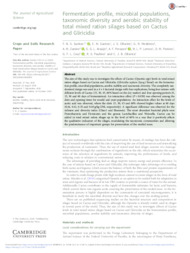Fermentation profile, microbial populations, taxonomic diversity and aerobic stability of total mixed ration silages based on Cactus and Gliricidia.
Fermentation profile, microbial populations, taxonomic diversity and aerobic stability of total mixed ration silages based on Cactus and Gliricidia.
Author(s): SANTOS, F. N. S.; SANTOS, E. M.; OLIVEIRA, J. S.; MEDEIROS, G. R.; ZANINE, A. M.; ARAUJO, G. G. L. de; PERAZZO, A. F.; LEMOS, M. L. P.; PEREIRA, D. M.; CRUZ, G. F. L.; PAULINO, R. S.; OLIVEIRA, C. J. B.
Summary: The aim of this study was to investigate the effects of Cactus (Opuntia spp) levels in total mixed ration silages based on Cactus and Gliricidia (Gliricidia sepium (Jacq.) Steud) on the fermentation profile, microbial populations, aerobic stability and taxonomic diversity. The completely randomized design was used in a 4 × 4 factorial design with four replications, being four rations with different levels of Cactus (15, 30, 45, 60% based on the dry matter) and four opening periods (0, 15, 30 and 60 days of fermentation). An interaction effect (P < 0.050) was observed among the diets and opening times for mould and yeast populations. An interaction effect for the levels of acetic acid was observed, where the diets 15, 30, 45 and 60% showed higher values at 60 days (0.44, 0.41, 0.35 and 0.40 g/kg DM, respectively). A significant difference was observed for the richness and diversity index (Chao1 and Shannon). The most abundant bacterial phyla were Proteobacteria and Firmicutes and the genera Lactobacillus and Weissella. Cactus can be added in total mixed ration silages up to the level of 60% in a way that it positively affects the qualitative indicators of the silages, modulating the taxonomic communities and allowing the predominance of important groups for preservation of the ensiled mass.
Publication year: 2020
Types of publication: Journal article
Unit: Embrapa Semi-arid Region
Observation
Some of Embrapa's publications are published as ePub files. To read them, use or download one of the following free software options to your computer or mobile device. Android: Google Play Books; IOS: iBooks; Windows and Linux: Calibre.
Access other publications
Access the Agricultural Research Database (BDPA) to consult Embrapa's full library collection and records.
Visit Embrapa Bookstore to purchase books and other publications sold by Embrapa.

